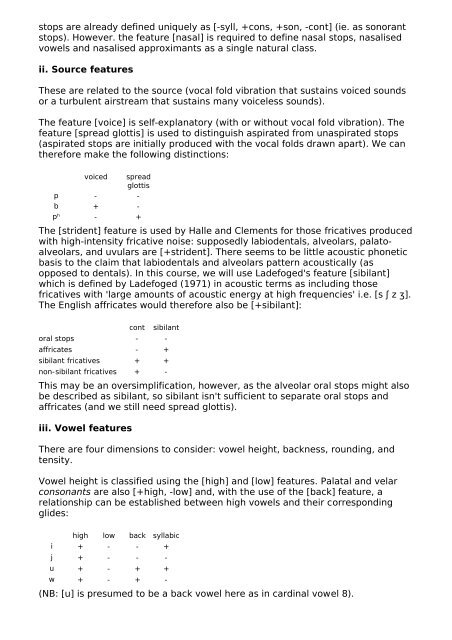Distinctive Features - Speech Resource Pages - Macquarie University
Distinctive Features - Speech Resource Pages - Macquarie University
Distinctive Features - Speech Resource Pages - Macquarie University
Create successful ePaper yourself
Turn your PDF publications into a flip-book with our unique Google optimized e-Paper software.
stops are already defined uniquely as [-syll, +cons, +son, -cont] (ie. as sonorant<br />
stops). However. the feature [nasal] is required to define nasal stops, nasalised<br />
vowels and nasalised approximants as a single natural class.<br />
ii. Source features<br />
These are related to the source (vocal fold vibration that sustains voiced sounds<br />
or a turbulent airstream that sustains many voiceless sounds).<br />
The feature [voice] is self-explanatory (with or without vocal fold vibration). The<br />
feature [spread glottis] is used to distinguish aspirated from unaspirated stops<br />
(aspirated stops are initially produced with the vocal folds drawn apart). We can<br />
therefore make the following distinctions:<br />
voiced spread<br />
glottis<br />
p - -<br />
b + -<br />
pʰ - +<br />
The [strident] feature is used by Halle and Clements for those fricatives produced<br />
with high-intensity fricative noise: supposedly labiodentals, alveolars, palatoalveolars,<br />
and uvulars are [+strident]. There seems to be little acoustic phonetic<br />
basis to the claim that labiodentals and alveolars pattern acoustically (as<br />
opposed to dentals). In this course, we will use Ladefoged's feature [sibilant]<br />
which is defined by Ladefoged (1971) in acoustic terms as including those<br />
fricatives with 'large amounts of acoustic energy at high frequencies' i.e. [s ʃ z ʒ].<br />
The English affricates would therefore also be [+sibilant]:<br />
cont sibilant<br />
oral stops - -<br />
affricates - +<br />
sibilant fricatives + +<br />
non-sibilant fricatives + -<br />
This may be an oversimplification, however, as the alveolar oral stops might also<br />
be described as sibilant, so sibilant isn't sufficient to separate oral stops and<br />
affricates (and we still need spread glottis).<br />
iii. Vowel features<br />
There are four dimensions to consider: vowel height, backness, rounding, and<br />
tensity.<br />
Vowel height is classified using the [high] and [low] features. Palatal and velar<br />
consonants are also [+high, -low] and, with the use of the [back] feature, a<br />
relationship can be established between high vowels and their corresponding<br />
glides:<br />
high low back syllabic<br />
i + - - +<br />
j + - - -<br />
u + - + +<br />
w + - + -<br />
(NB: [u] is presumed to be a back vowel here as in cardinal vowel 8).
















